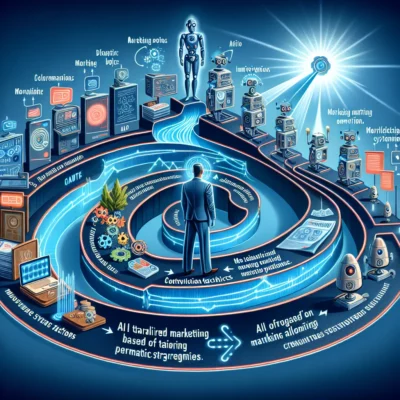The Rise of AI in Marketing
Artificial Intelligence (AI) has transformed the landscape of marketing in ways previously unimaginable. From its humble beginnings, AI has evolved into a powerful tool that enables marketers to deliver highly personalized experiences to their customers.
Brief History of AI in Marketing
The journey of AI in marketing began with simple algorithms and basic data analysis. Over time, advancements in machine learning and data processing have paved the way for more sophisticated AI applications. Key milestones include:
- Early 2000s: Introduction of basic recommendation systems.
- 2010s: Emergence of machine learning algorithms that could process vast amounts of data.
- Late 2010s: Development of AI-driven tools for real-time data analysis and customer insights.
The Shift from Traditional to AI-Driven Strategies
Traditional marketing strategies relied heavily on broad demographic data and generalized messaging. AI has shifted this approach by enabling marketers to analyze individual customer behaviors and preferences, leading to highly targeted and effective marketing campaigns.
Understanding Personalization and Customization
Definitions and Differences
- Personalization: Tailoring content and experiences to individual users based on their behavior, preferences, and past interactions.
- Customization: Allowing users to choose their preferences and configure their experiences according to their needs.
Why They Matter in Modern Marketing
In today’s competitive market, personalization and customization are crucial for engaging customers and building loyalty. They help in:
- Improving Customer Experience: Personalized experiences make customers feel valued and understood.
- Increasing Engagement: Customized content is more relevant and likely to capture attention.
- Boosting Conversions: Tailored recommendations and offers can lead to higher sales.
Examples of Successful Personalized Marketing Campaigns
- Spotify: Uses AI to create personalized playlists based on listening habits.
- Amazon: Recommends products based on previous purchases and browsing history.
- Netflix: Suggests shows and movies tailored to individual viewing preferences.
AI-Driven Personalization Techniques
Data Collection and Analysis
AI gathers and processes customer data through various means, including:
- Website Interactions: Tracking user behavior on websites.
- Social Media Activity: Analyzing engagement on social platforms.
- Purchase History: Monitoring past purchases to predict future needs.
The Role of Machine Learning in Understanding Customer Behavior
Machine learning algorithms analyze data to identify patterns and trends. This helps in understanding customer behavior and preferences, enabling more accurate targeting.
Predictive Analytics
AI uses predictive analytics to forecast customer needs and preferences. This involves:
- Analyzing Historical Data: Using past behavior to predict future actions.
- Identifying Trends: Spotting emerging patterns that indicate customer interests.
- Case Studies: Companies like Starbucks use predictive analytics to tailor promotions and offers to individual customers.
Dynamic Content Generation
AI tools can create personalized content in real-time, such as:
- Email Campaigns: Crafting personalized messages based on user data.
- Web Content: Displaying different content to different users based on their behavior.
- Benefits: Dynamic content increases engagement and improves user experience.
Customization Through AI
Product Recommendations
AI tailors product suggestions to individual users by analyzing:
- Browsing History: What products users have viewed.
- Purchase Patterns: What products users have bought.
- Impact: Personalized recommendations lead to higher sales and customer satisfaction.
Personalized Email Marketing
Crafting AI-driven email campaigns involves:
- Segmentation: Dividing the audience into segments based on behavior and preferences.
- Personalized Content: Creating tailored messages for each segment.
- Metrics: Tracking open rates, click-through rates, and conversion rates to measure success.
Chatbots and Virtual Assistants
AI-powered chatbots enhance customer service by:
- Providing Instant Responses: Answering customer queries in real-time.
- Offering Personalized Assistance: Tailoring responses based on customer data.
- Real-World Examples: Companies like H&M use AI chatbots to assist customers with product recommendations and support.
Overcoming Challenges in AI Personalization
Data Privacy and Ethical Considerations
Ensuring customer data protection is paramount. Key points include:
- Compliance: Adhering to data protection regulations like GDPR.
- Transparency: Being clear about data collection and usage.
- Balancing Personalization with Privacy: Offering opt-out options for customers.
Integration with Existing Systems
Seamless AI integration involves:
- Compatibility: Ensuring AI tools work with existing marketing platforms.
- Training: Educating staff on using AI tools effectively.
- Avoiding Pitfalls: Common issues include data silos and integration challenges.
The Future of AI in Marketing
Emerging Trends and Technologies
The future of AI in marketing looks promising with trends such as:
- Voice Search Optimization: Tailoring content for voice-activated devices.
- Augmented Reality (AR): Enhancing customer experiences with AR.
- Hyper-Personalization: Using AI to deliver even more personalized experiences.
Predictions for the Next Decade
- Increased Automation: More tasks will be automated, freeing up time for strategic planning.
- Advanced Analytics: Improved analytics for deeper customer insights.
- AI-Driven Creativity: AI will assist in creative processes, from content creation to campaign design.
How Businesses Can Stay Ahead of the Curve
- Invest in AI Tools: Stay updated with the latest AI technologies.
- Continuous Learning: Keep up with AI advancements and trends.
- Experiment and Innovate: Don’t be afraid to try new AI-driven strategies.
Your Next Steps
Practical Tips for Implementing AI in Your Marketing Strategy
- Start Small: Begin with a pilot project to test AI capabilities.
- Set Clear Goals: Define what you want to achieve with AI.
- Measure Results: Track performance and adjust strategies accordingly.
Resources and Tools to Get Started
- AI Platforms: Tools like IBM Watson and Google AI.
- Learning Resources: Online courses and tutorials on AI in marketing.
- Industry Reports: Stay informed with the latest research and case studies.
Encouragement to Experiment and Innovate
The world of AI in marketing is full of possibilities. Embrace the technology, experiment with new ideas, and innovate to stay ahead in the competitive landscape.
AI has the potential to revolutionize your marketing strategy, offering unparalleled personalization and customization. By leveraging AI, you can create more meaningful connections with your customers, drive engagement, and boost your bottom line. The future of marketing is here, and it’s powered by AI.



